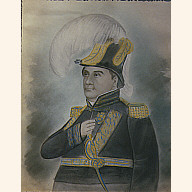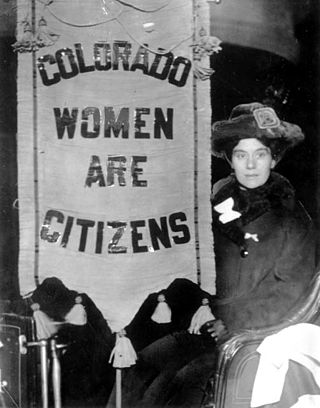
The Nineteenth Amendment to the United States Constitution prohibits the United States and its states from denying the right to vote to citizens of the United States on the basis of sex, in effect recognizing the right of women to vote. The amendment was the culmination of a decades-long movement for women's suffrage in the United States, at both the state and national levels, and was part of the worldwide movement towards women's suffrage and part of the wider women's rights movement. The first women's suffrage amendment was introduced in Congress in 1878. However, a suffrage amendment did not pass the House of Representatives until May 21, 1919, which was quickly followed by the Senate, on June 4, 1919. It was then submitted to the states for ratification, achieving the requisite 36 ratifications to secure adoption, and thereby went into effect, on August 18, 1920. The Nineteenth Amendment's adoption was certified on August 26, 1920.

Socorro is a city in Socorro County in the U.S. state of New Mexico. It is in the Rio Grande Valley at an elevation of 4,579 feet (1,396 m). In 2010 the population was 9,051. It is the county seat of Socorro County. Socorro is located 74 miles (119 km) south of Albuquerque and 146 miles (235 km) north of Las Cruces.
Luis Lopez is an unincorporated community and census-designated place in Socorro County, New Mexico, United States. It lies between Socorro and San Antonio along the Rio Grande.

Elfego Baca was a gunfighter, law enforcement officer, lawyer, and politician in New Mexico, who became an American folk hero of the later years of the New Mexico Territory frontier. His goal in life was to be a peace officer, and for "the outlaws to hear [his] steps a block away". He is known for his involvement in an 1884 shootout in Frisco, New Mexico, as well as later fictionalized representations of his life in Westerns released during the mid-20th century.

Manuel Armijo was a New Mexican soldier and statesman who served three times as governor of New Mexico between 1827 and 1846. He was instrumental in putting down the Revolt of 1837; he led the military forces that captured the invaders of the Texan Santa Fe Expedition; and he later surrendered to the United States in the Mexican–American War, leading to the capture of Santa Fe and occupation of New Mexico by the American army. Armijo attempted to expand Hispanic settlements and bolster the security of New Mexico by granting large acreages of land to prominent individuals. Armijo has been vilified by Americans participating in the conquest of New Mexico and some subsequent historians.

San Miguel de Socorro is the Catholic church in Socorro, New Mexico, built on the ruins of the old Nuestra Señora de Socorro mission. The old mission was built around 1627, but was destroyed in 1680 during the Pueblo Revolt. A portion of the adobe wall of the old church remains today and still can be seen behind glass just left of the altar. The building was listed on the National Register of Historic Places in 2016.

Interstate 25 (I-25) in the US state of New Mexico follows the north–south corridor through Albuquerque and Santa Fe. It replaced U.S. Route 85 (US 85), which is no longer signed, but still exists in route logs sharing most of the I-25 alignment. I-25 starts in New Mexico at an interchange with I-10 in Las Cruces and extends roughly 460 miles (740 km) before reaching Colorado. I-25 passes through principally rural land through central New Mexico and passes through or near the cities of Las Cruces, Truth or Consequences, Socorro, Belen, Albuquerque, Santa Fe, Las Vegas, and Raton.

Ina Cassidy was an American writer, sculptor, suffragist, teacher and lecturer.

Fabiola Cabeza de Baca Gilbert was an American educator, nutritionist, activist and writer. She was also the first known published author of a cookbook describing New Mexican cuisine. Cabeza de Baca was fluent in Spanish, English, Tewa and Tiwa.

Julia Duncan Brown Asplund (1875-1958) was the first librarian for the University of New Mexico and the first woman to serve on the University of New Mexico Board of Regents.

The Suffrage Special was an event created by the Congressional Union for Woman Suffrage in 1916. The Suffrage Special toured the "free states" which had already allowed women's suffrage in the United States. The delegates were raising awareness of the national women's suffrage amendment. They were also looking to start a new political party, the National Women's Party (NWP). The Suffrage Special, also known as the "flying squadron" left Washington, D.C., and toured the Western states by train for 38 days starting on April 9, 1916. Famous and well-known suffragists made up the envoy of the Suffrage Special. They toured several states during their journey and were largely well-received. When the tour was over, the delegates of the Suffrage Special visited Congress where they presented petitions for women's suffrage they had collected on their journey.
Aurora Lucero-White Lea was an American folklorist, writer, and suffragist. She was a proud Nuevomexicana, advocating for bilingual education in English and Spanish and working to preserve the heritage of the Hispanic Southwest. Lucero-White Lea is best known for her 1953 work Literary Folklore of the Hispanic Southwest, a compilation of cultural traditions, songs, and stories collected while traveling northern New Mexico.
This is a timeline of women's suffrage in New Mexico. Women's suffrage in New Mexico first began with granting women the right to vote in school board elections and was codified into the New Mexico State Constitution, written in 1910. In 1912, New Mexico was a state, and suffragists there worked to support the adoption of a federal women's suffrage amendment to allow women equal suffrage. Even after white women earned the right to vote in 1920, many Native Americans were unable to vote in the state.
The fight for women's suffrage in New Mexico was incremental and had the support of both Hispanic and Anglo women suffragists. When New Mexico was a territory, women had the right to vote in school board elections. When New Mexico created its state constitution in 1910, it continued to allow women to vote in school elections, but it was nearly impossible to modify the constitution for suffrage any further. Women in the state chose to pursue advocating for a federal women's suffrage amendment. They organized among both English and Spanish speaking groups. Many New Mexico politicians supported suffrage on a federal level. Continued advocacy on behalf of suffragists in the state allowed New Mexico to become the 32nd state to ratify the Nineteenth Amendment on February 21, 1920.

Ada McPherson Morley was an American author, suffragist and rancher. Early in her time in New Mexico, she and her husband edited a newspaper and took on the Santa Fe Ring both in print and in business matters. Morley became involved with the New Mexico chapter of the Women's Christian Temperance Union (WCTU) and later served as president. She was also involved in women's suffrage in New Mexico and helped recruit women into the Congressional Union (CU) later in her life. Morley owned a ranch in the Datil Mountains where she raised cattle and was able to host meetings.

In 1893, Colorado became the second state in the United States to grant women's suffrage and the first to do so through a voter referendum. Even while Colorado was a territory, lawmakers and other leaders tried to include women's suffrage in laws and later in the state constitution. The constitution did give women the right to vote in school board elections. The first voter referendum campaign was held in 1877. The Woman Suffrage Association of Colorado worked to encourage people to vote yes. Nationally-known suffragists, such as Susan B. Anthony and Lucy Stone spoke alongside Colorado's own Alida Avery around the state. Despite the efforts to influence voters, the referendum failed. Suffragists continued to grow support for women's right to vote. They exercised their right to vote in school board elections and ran for office. In 1893, another campaign for women's suffrage took place. Both Black and white suffragists worked to influence voters, gave speeches, and turned out on election day in a last-minute push. The effort was successful and women earned equal suffrage. In 1894, Colorado again made history by electing three women to the Colorado house of representatives. After gaining the right to vote, Colorado women continued to fight for suffrage in other states. Some women became members of the Congressional Union (CU) and pushed for a federal suffrage amendment. Colorado women also used their right to vote to pass reforms in the state and to support women candidates.

This is a timeline of women's suffrage in Colorado. Women's suffrage efforts started in the late 1860s. During the state constitutional convention for Colorado, women received a small win when they were granted the right to vote in school board elections. In 1877, the first women's suffrage referendum was defeated. In 1893, another referendum was successful. After winning the right to vote, Colorado women continued to fight for a federal women's suffrage amendment. While most women were able to vote, it wasn't until 1970 that Native Americans living on reservations were enfranchised.













